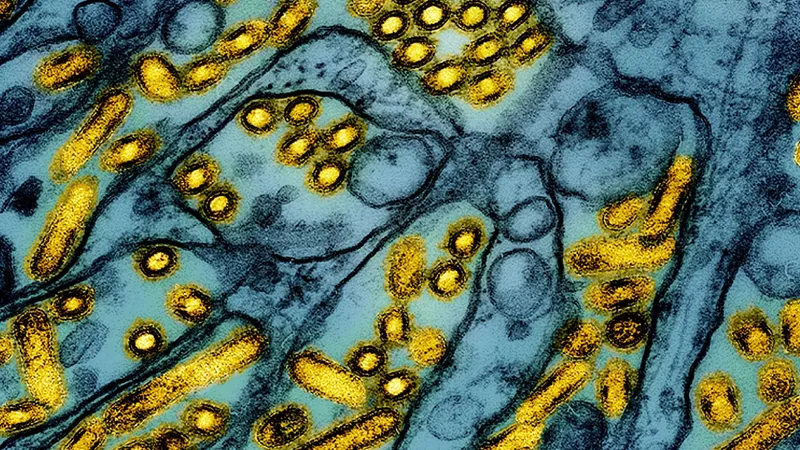
Urgent Warning: CDC Discovers Troubling Bird Flu Mutation – What You Need to Know!
2024-12-30
Author: Jacob
Urgent Warning: CDC Discovers Troubling Bird Flu Mutation – What You Need to Know!
As health officials issue warnings regarding a "concerning" new mutation of the bird flu virus, concerns are rising over its potential to infect humans more easily. Since March of this year, the U.S. has reported over 60 human infections of bird flu, mostly mild and primarily among farmworkers who were in close contact with infected poultry or cattle. However, alarming cases of transmission remain, with one adult in Missouri and a child in California prompting an investigation into undetermined origins of their infections.
California has been hit hard, with the state officially declaring an emergency as the outbreak surges through dairy farms. Cases have also been confirmed in several Midwestern states, including Iowa, Michigan, Missouri, and Wisconsin.
Understanding Bird Flu
According to the Centers for Disease Control and Prevention (CDC), bird flu, caused by avian influenza A viruses, predominantly spreads among birds but can jump to humans in rare instances. The strain that is currently concerning experts is H5N1, which has been responsible for human infections.
While it is crucial to note that the overall risk to the public remains low and there has been no documented human-to-human transmission, the CDC is monitoring the situation closely. The agency identifies six subtypes of bird flu that have been known to infect humans: H3, H5, H6, H7, H9, and H10.
Risks to Household Pets
Not only does the bird flu pose dangers to humans, but it can also affect pets, particularly cats, which appear to be particularly susceptible to the H5N1 strain. Since March, dozens of domestic, feral, and even big cats in zoos have contracted the virus, leading to a voluntary recall of specific pet food that was thought to be contaminated.
How is Bird Flu Spread?
The transmission of bird flu to humans most frequently occurs through direct contact with infected birds or animals. Historical cases of human-to-human transmission have been rare and usually limited to close contacts.
A Mutation to Monitor
Recent genetic studies have indicated that a troubling mutation occurred in a Louisiana patient suffering from what is identified as the first severe case in the U.S. Experts believe that such mutations might enhance the virus's ability to bind to human receptors, thus raising alarms despite the CDC asserting that the general risk remains unchanged.
Experts like Michael Osterholm, an infectious disease researcher, warn that while the virus has shown slight mutations, it does not currently indicate it will spread between humans like COVID-19. However, vigilance is essential, as history may repeat itself when it comes to pandemics.
Symptoms to Watch Out For
Recognizing the symptoms associated with bird flu is crucial: - **Mild Symptoms:** - Eye redness and irritation - Low-grade fever - Cough and sore throat - Runny or stuffy nose - Muscle aches and fatigue - **Moderate to Severe Symptoms:** - High fever - Shortness of breath or difficulty breathing - Altered consciousness or seizures Felines exhibiting symptoms may include loss of appetite, lethargy, fever, or even irritability.
What Should You Do?
If you suspect you or your animal may be infected, immediate consultation with a healthcare professional or veterinarian is advisable. Antiviral medications exist but are most effective when administered within 48 hours of symptom onset.
Conclusion: Stay Informed!
The CDC continues to stress the importance of monitoring this situation closely. While the overall risk remains low, the potential for change in transmission dynamics warrants vigilance among the public and those working closely with livestock. Stay tuned to trusted health sources for the latest updates on bird flu and keep yourself and your pets safe!



 Brasil (PT)
Brasil (PT)
 Canada (EN)
Canada (EN)
 Chile (ES)
Chile (ES)
 Česko (CS)
Česko (CS)
 대한민국 (KO)
대한민국 (KO)
 España (ES)
España (ES)
 France (FR)
France (FR)
 Hong Kong (EN)
Hong Kong (EN)
 Italia (IT)
Italia (IT)
 日本 (JA)
日本 (JA)
 Magyarország (HU)
Magyarország (HU)
 Norge (NO)
Norge (NO)
 Polska (PL)
Polska (PL)
 Schweiz (DE)
Schweiz (DE)
 Singapore (EN)
Singapore (EN)
 Sverige (SV)
Sverige (SV)
 Suomi (FI)
Suomi (FI)
 Türkiye (TR)
Türkiye (TR)
 الإمارات العربية المتحدة (AR)
الإمارات العربية المتحدة (AR)